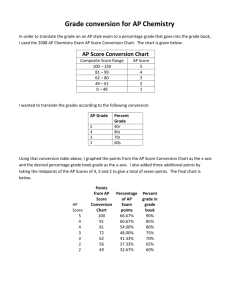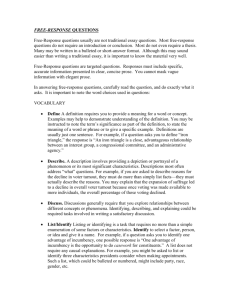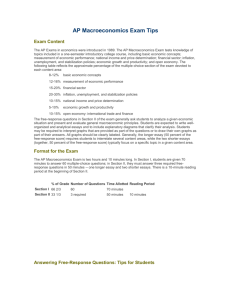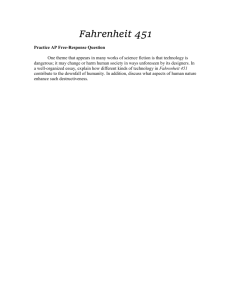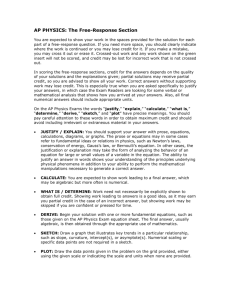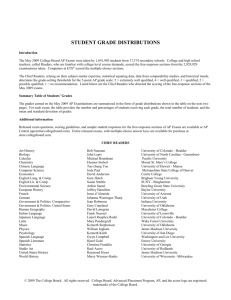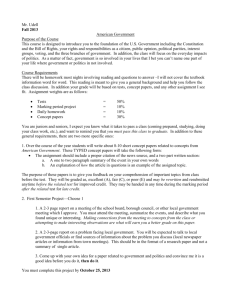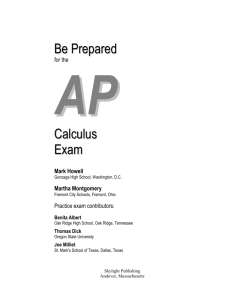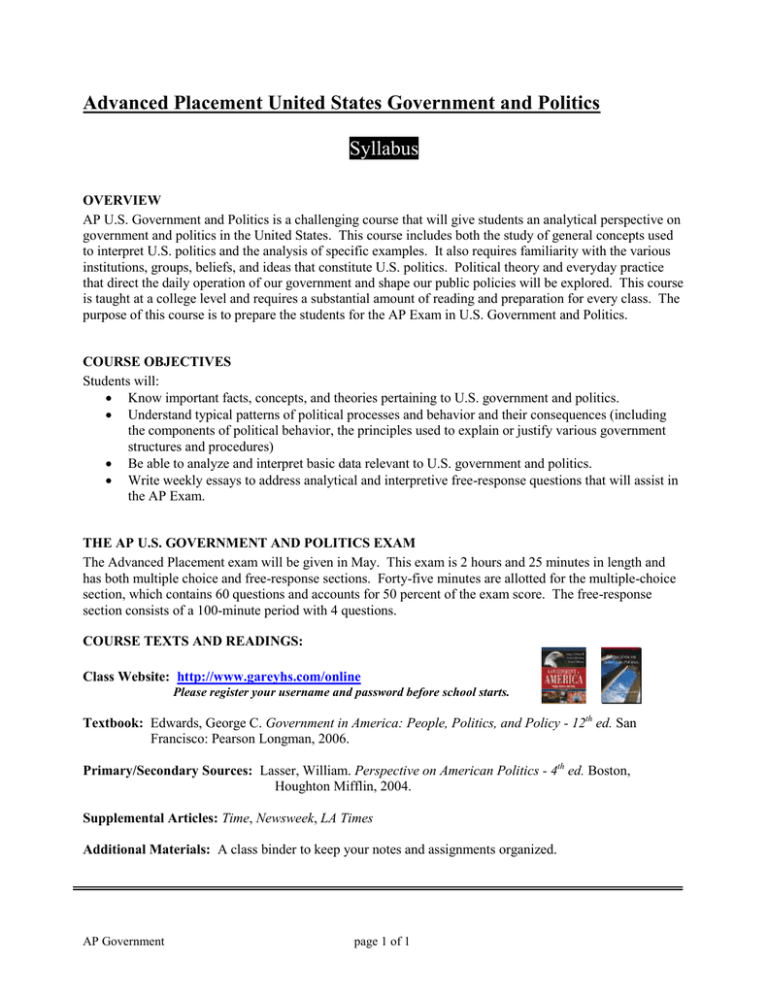
Advanced Placement United States Government and Politics
Syllabus
OVERVIEW
AP U.S. Government and Politics is a challenging course that will give students an analytical perspective on
government and politics in the United States. This course includes both the study of general concepts used
to interpret U.S. politics and the analysis of specific examples. It also requires familiarity with the various
institutions, groups, beliefs, and ideas that constitute U.S. politics. Political theory and everyday practice
that direct the daily operation of our government and shape our public policies will be explored. This course
is taught at a college level and requires a substantial amount of reading and preparation for every class. The
purpose of this course is to prepare the students for the AP Exam in U.S. Government and Politics.
COURSE OBJECTIVES
Students will:
Know important facts, concepts, and theories pertaining to U.S. government and politics.
Understand typical patterns of political processes and behavior and their consequences (including
the components of political behavior, the principles used to explain or justify various government
structures and procedures)
Be able to analyze and interpret basic data relevant to U.S. government and politics.
Write weekly essays to address analytical and interpretive free-response questions that will assist in
the AP Exam.
THE AP U.S. GOVERNMENT AND POLITICS EXAM
The Advanced Placement exam will be given in May. This exam is 2 hours and 25 minutes in length and
has both multiple choice and free-response sections. Forty-five minutes are allotted for the multiple-choice
section, which contains 60 questions and accounts for 50 percent of the exam score. The free-response
section consists of a 100-minute period with 4 questions.
COURSE TEXTS AND READINGS:
Class Website: http://www.gareyhs.com/online
Please register your username and password before school starts.
Textbook: Edwards, George C. Government in America: People, Politics, and Policy - 12th ed. San
Francisco: Pearson Longman, 2006.
Primary/Secondary Sources: Lasser, William. Perspective on American Politics - 4th ed. Boston,
Houghton Mifflin, 2004.
Supplemental Articles: Time, Newsweek, LA Times
Additional Materials: A class binder to keep your notes and assignments organized.
AP Government
page 1 of 1
SAMPLE ASSIGNMENTS AND ASSESSMENTS:
Examine public opinion polls
Look at and analyze US Census data
Write answers to College Board FRQ’s (minimum of 4)
Analyze pie charts and graphs of the federal budget, e.g. incomes and expenditures
Analyze political cartoon on current topics
Compare two sets of news articles covering the same topic for bias
Use online resources to research and create a short biography of their representatives
Create an election portfolio
Debate contemporary issues
Analyze an electoral map from the most recent presidential election
Analyze contemporary news sources
Compare John Locke and the Declaration of Independence
Analyze the State of the Union speech
Grading:
A+ = 100 – 97%
A = 96 – 94 %
A- = 93 – 90 %
B+ = 89 – 87%
B = 86 – 84 %
B- = 83 – 80 %
C+ = 79 – 77%
C = 76 – 74 %
C- = 73 – 70 %
D+ = 69 – 67%
D = 66 – 64 %
D- = 63 – 60 %
F = 59 – 0 %
AP Government
page 2 of 2
Unit I:
Introducing Government in America
Readings:
Edwards:
Chapter 1 (p.2 - 27)
Key Concepts: Democracy, Elite and class theory, Government, Gross Domestic Product, Hyper-pluralism, Individualism,
Linkage Institutions, Majority rule, Minority rights, Pluralist theory, Policy agenda, Policy gridlock, Policy
making institutions, Policymaking system, Political issue, Political participation, Politics, Public goods,
Public policy, Representation, Single issue groups.
Learning
Objectives:
1.
2.
3.
4.
5.
6.
Distinguish among the fundamental concepts of government, politics, and public policy.
Understand how government, politics and public policy are interrelated.
How can people influence the government’s policy agenda?
Describe the basic concept of policy-making system.
Determine the principles of traditional democratic theory.
Explain the three contemporary theories of American democracy: pluralism, elite and class theory, and
hyper-pluralism.
7. Analyze and discuss the challenges to democracy presented in the text.
8. Explain the importance of Individualism in limiting the scope of American government.
Unit II:
Constitutional Underpinnings
Readings:
Edwards:
Primary/Secondary Sources:
AP Government
Chapter 2 (p. 28-65)
The United States Constitution
The Bill of Rights
John Locke’s Treatise on Government (#1)
page 3 of 3
Federalist #51
Content:
1. Events and philosophies that
influenced the writings of the
2. Constitution.
3. Separation of powers
4. Checks and balances
5. The Articles of the Constitution
6. The Bill of Rights
Free-Response: Analytical and interpretive free-response question (Topic: Constitutional Underpinnings)
Key Concepts: Anti-Federalists, Articles of Confederation, Bill of Rights, Checks and Balances, Connecticut Compromise,
Consent of the governed, Constitution, Declaration of Independence, Equal Rights Amendment, Factions,
Federalist Papers, Federalists, Judicial review, Limited government, Marbury vs. Madison, Natural Rights,
New Jersey Plan, Republic, Separation of Powers, Shays’ Rebellion, U.S. Constitution, Virginia Plan, Writ of
Habeas Corpus.
Learning
Objectives:
1.
2.
3.
Outline the events that led early Americans to declare independence from Britain.
Explain the basic philosophy that underlies the Declaration of Independence.
Summarize the parallels between Locke’s writings and Jefferson’s language in the Declaration of
Independence.
4. Explain how the weaknesses of the Articles of Confederation laid the groundwork for the Constitution.
5. Describe what Madison meant by “factions” and how he proposed to solve the problems pressed by
factions.
6. Describe how the Constitutional Convention dealt with issues of equality.
7. Summarize the major compromises of the Constitutional Convention.
8. Explain why economic issues were high in the agenda at the Constitutional Convention and how the
framers tried to strengthen the economic powers of the new national government.
9. Demonstrate what we mean by the “Madisonian model” and how it is incorporated within the
Constitution.
10. Describe the major issues between the Federalists and the Anti-federalists in the debates over ratification
of the Constitution.
11. Express how the constitutional changes – both formal and informal – continue to shape and alter the
Madisonian system.
12. How does the Constitution affect the scope of government in America.
Unit III:
Federalism
Readings:
Edwards :
Primary/Secondary Sources:
Content:
1.
2.
3.
4.
AP Government
Chapter 3 (p.66 – 95)
Federalist # 10, #39, #45
Article 6 of the US Constitution
Amendment 10
Supremacy clause
The 10th Amendment
Grants
State obligations to other states
page 4 of 4
Free-Response: Analytical and interpretive free-response question (Topic: Federalism)
Key Concepts: Block grants, Categorical grants, Cooperative federalism, Dual federalism, Elastic clause, Enumerated
powers, Extradition, Federalism, Fiscal federalism, Formula grants, Full faith and credit, Gibbons vs. Ogden,
Implied Powers, Intergovernmental relations, McCulloch vs. Maryland, Privileges and Immunities, Project
grant, Supremacy clause, Tenth Amendment, Unitary government
Learning
Objectives:
1.
2.
3.
4.
5.
6.
7.
8.
9.
Describe the three basic forms of governmental structures: Federalism, Unitary, and Confederacy.
Identify the ways in which the Constitution determines the powers of state and the national government.
How have contrasting interpretations of the supremacy clause and the 10th Amendment lead to divergent
views of the scope of state and national powers.
Describe how the Supreme Court set forth the principle of implied powers in the McCulloch vs.
Maryland case.
Describe the relationship of implied powers to enumerated powers.
Describe how the Civil War and the civil rights movement contributed to the development of national
supremacy over the states.
List the clauses in the Constitution that define the obligations that each state has to every other state.
Describe what is meant by fiscal federalism and assess the role that federal money plays in state
policies?
Identify the positive and negative effects American federalism has on democracy.
Unit IV:
Civil Liberties
Readings:
Edwards:
Primary/Secondary Sources:
Content:
1. The “due process” clause of
the 14th amendment
2. Incorporation
3. Individual civil liberties
Chapter 4 (p.96 - 137)
The Bill of Rights
14th Amendment
Gitlow v. New York
Free-Response: Analytical and interpretive free-response question (Topic: Civil Liberties)
Key Concepts: Bill of Rights, Civil Liberties, Commercial Speech, Cruel and Unusual Punishment, Eighth Amendment,
Establishment clause, Exclusionary rule, Fifth Amendment, First Amendment, Free exercise clause,
Incorporation Doctrine, Libel, Plea Bargaining, Prior restraint, Probable cause, Right to privacy, Search
Warrant, Self Incrimination, Sixth Amendment, Symbolic speech, Unreasonable searches and seizures.
Learning
Objectives:
1.
2.
3.
AP Government
How have decisions of the Supreme Court extended specific provisions of the Bill of Rights to the states
as part of the incorporation doctrine.
Describe how the two constitutional statements about religion and government – the establishment
clause and the free exercise clause – may sometimes conflict.
What may have the First Congress intended by the terms establishment and free of religion.
page 5 of 5
4.
5.
Why will the Supreme Court usually not permit prior restraint on speech and press.
Explain why it has been so difficult for the courts to clearly define which types of materials are
considered to be obscene.
6. Differentiate between freedom of speech and related concepts like symbolic speech and freedom of
expression.
7. Identify the two facets of freedom of assembly and explain how they may conflict with other societal
values.
8. Explain how specific provisions of the Bill of Rights have been used to extend basic rights to defendants
in criminal trials.
9. How can concepts such as a right to privacy be inferred or implied from the Bill of Rights.
10. Explain why civil liberties are seen as an individual’s protection against the government.
Unit V:
Civil Rights
Readings:
Edwards:
Primary/Secondary Sources:
Content:
1. “Equal protection” clause
2. Judicial interpretation
3. 1964 Civil Rights Act
Chapter 5 (p.138 - 175)
Amendment 14
Dred Scott v.Sandford
Plessy v. Ferguson
Brown v. Board of Education
Title 7 of the 1964 Civil Rights Act
Free-Response: Analytical and interpretive free-response question (Topic: Civil Rights Cases)
Key Concepts: Affirmative Action, Americans with Disabilities Act of 1990, Civil Rights, Civil Rights Act of 1964,
Comparable worth, Equal Protection of the Laws, Equal Rights Amendment, Fifteenth Amendment,
Fourteenth Amendment, Nineteenth Amendment, Poll Taxes, Suffrage, Thirteenth Amendment, Twentyfourth Amendment, Voting Rights Act of 1965, White Primary.
Learning
Objectives:
1.
2.
3.
4.
5.
6.
7.
AP Government
How have civil rights been used to extend more equality to groups that historically have been subject to
discrimination.
Differentiate between interpretations of equality, such as equality of opportunity contrasted with
equality of results.
Identify provisions of the Bill of Rights that have implications for equality.
Explain how the Fourteenth Amendment guarantee of “equal protection under the laws” has been
applied to the idea of equality.
Summarize the reasoning of the Court in the 1954 case of Brown vs. Board of Education and this case to
show how the Court set aside its earlier precedent in Plessy vs. Ferguson.
Explain the significance of Civil Rights Act of 1964 and explain why efforts for civil rights legislation
were finally successful in the mid–1960s.
Trace the attempts of southern states to deny African Americans the right to vote even after the passage
of the Fifteenth Amendment.
page 6 of 6
8.
Identify the ways in which Americans with disabilities have become the successors to civil rights
movement.
9. Explain why gay and lesbian activists may face a tough battle for equality.
10. Describe the opposing positions of those who favor affirmative action and those who claim that these
policies simply create reverse discrimination.
11. Analyze how the important democratic principles of equality and individual liberty may actually conflict
with each other.
12. Describe how civil rights increase the scope and power of government.
Unit VI:
Public Opinion
Readings:
Edwards:
Primary/Secondary Sources:
Content:
1. U.S. demographics
2. Measuring public opinion
3. The impact of public opinion
Chapter 6 (p.176 - 209)
Alexis de Tocqueville’s Democracy in America
The Other War Room (Lasser)
Free-Response: Analytical and interpretive free-response question (Topic: Public Opinion Issues)
Key Concepts: Census, Civil disobedience, Demography, Exit poll, Gender gap, Melting Pot, Minority, Political culture,
Political ideology, Political participation, Political socialization, Protest, Public opinion, Random digit
dialing, Random sampling, Reapportionment, Sample, Sampling error.
Learning
Objectives:
1.
Contrast the relative positions of African American, Hispanic Americans, Asian Americans, and Native
Americans in the American political and economic spheres.
2. Identify the political implications of an increasingly elderly population.
3. Describe the process of political socialization and identify the primary agents of socialization.
4. Outline the components that are essential if one wants to obtain accuracy in public opinion polling.
5. What is the role of polls in American democracy.
6. Identify the political beliefs that are likely to be preferred by liberals and conservatives.
7. Identify the activities that encompass political participation in the United States.
8. Distinguish between conventional and unconventional types of political participation.
9. Demonstrate how non-violent civil disobedience was one of the most effective techniques of the civil
rights movement in the American South.
10. Explain what political scientists mean when they conclude that Americans are ideological conservatives
but operational liberals.
Unit VII:
The Mass Media
Readings:
Edwards:
Primary/Secondary Sources:
AP Government
Chapter 7 (p.210 - 237)
New York Times v. United States
Bias (Lasser)
page 7 of 7
Content:
1. History of media
2. Political media
3. Change in relations between
media and politicians over time
Free-Response: Analytical and interpretive free-response question (Topic: Mass Media and Influence)
Key Concepts: Beats, Broadcast media, Chains, High-tech Politics, Investigative journalism, Mass media, Media event,
Narrowcasting, Policy agenda, Policy entrepreneurs, Press conference, Print media, sound bites, Talking
head, Trial balloons.
Learning
Objectives:
1.
Trace the development of the mass media and the way in which presidents have used the media in
different periods of our history.
2. Describe the major sources that people rely on for their information about politics.
3. Attempt to explain how journalists define what is newsworthy, where they get their information, and
how they present it.
4. Explain the role that the profit motive plays in decisions by the mass media on how to report the news.
5. Explain the charge that the media have a liberal bias.
6. Identify factors that would explain why the news is typically characterized by political neutrality.
7. What are the methods used by political activists to get their ideas placed high on the governmental
agenda.
8. How does the media act as key linkage institutions between the people and the policymakers.
9. Explain how functions of the media may help to keep government small and those functions that may
encourage the growth of government.
10. Describe how the rise of television broadcasting has encouraged individualism in the American political
system.
11. Explain why the rise of the "information society" has not brought about a corresponding rise of an
"informed society."
12. Summarize how the news and its presentation are in1portant influences ill shaping public opinion on
political issues.
Unit VIII:
Political Parties
Readings:
Edwards:
Primary/Secondary Sources:
Content:
1. Function of political parties
2. Organization of political parties
3. Role of political parties in the
political process
AP Government
Chapter 8 (p.238 – 265)
RNC and DNC party platforms
The Crabgrass Wars (Lasser)
page 8 of 8
Free-Response: Analytical and interpretive free-response question (Topic: Political Parties and Government)
Key Concepts: Blanket primaries, Coalition, Coalition government, Closed primaries, Critical election, Linkage institutions,
National chairperson, National committee, National convention, New Deal coalition, Open primaries, Party
competition, Party de-alignment, Party eras, Party identification, Party image, Party machine, Party
neutrality, Party re-alignment, Patronage, Political party, Proportional representation, Rational-choice theory,
Responsible party model, Third parties, Ticket splitting, Winner-take-all system.
Learning
Objectives:
1.
What are the roles of the party-in-the-electorate, the party as an organization, and the party-ingovernment?
2. Describe Anthony Downs' rational-choice theory as a working model of the relationship among citizens,
parties, and policy.
3. Trace the historical development of the American two-party system.
4. Describe what is meant by party eras, critical elections, and party realignment.
5. Examine the significance of divided government and explain how the recent pattern of divided
government may explain party de-alignment.
6. Differentiate between the ideology and party philosophy of the Democratic and Republican parties.
7. Explain how electoral rules such as the "winner-take-all" plurality system have helped to maintain a
two-party system in the United States.
8. What is the impact of third parties on American politics and the American party system?
9. Describe the consequences or effects of the American two-party system as contrasted with a multi-party
system.
10. Explain the significance of the weak and decentralized character of the American party system.
Unit IX:
Nominations and Campaigns
Readings:
Edwards:
Primary/Secondary Sources:
Content:
1. Caucuses and primaries
2. Candidate qualifications and
voting preferences
3. The effect of the media on modern
campaigns
Chapter 9 (p.266 – 295)
Federal Election Campaign Act of 1974
Free-Response: Analytical and interpretive free-response question (Topic: Campaigning in America)
Key Concepts: Campaign strategy, Caucus, Direct mail, Federal Election Campaign Act, Federal Election Commission,
Frontloading, Matching Funds, McGovern-Fraser Commission, National party convention, National primary,
Nomination, party platform, Political Action Committee, Presidential Election Campaign Fund, Presidential
primaries, regional primaries, Selective perception, Soft money, Superdelegates.
Learning
AP Government
page 9 of 9
Objectives:
1.
2.
3.
4.
5.
6.
7.
8.
Describe the role of campaign strategy in winning a nomination to elective office.
Describe and evaluate the caucus and primary methods of delegate selection.
Contrast the American primary system of nomination with those of other nations such as Great
Britain.
Consider the ways that high-tech campaigning has changed the nature of American politics.
Explain the growth of PACs and their impact on modern campaigning.
What is the crucial role of money and technology in American campaign organizations?
Analyze the role the media play In influencing the style and substance of presidential campaigns.
Discuss the three effects that campaigns have on voters: reinforcement, activation, and
conversion.
Unit X:
Elections and Voting Behavior
Readings:
Edwards:
Primary/Secondary Sources:
Content:
1. Types of elections
2. Voting patterns
Chapter 10 (p.296 – 321)
Breaking the Two-Party Monopoly (Lasser)
Free-Response: Analytical and interpretive free-response question (Topic: Analyze Election Data for Presidential
Election 2000)
Key Concepts: Civic duty, Electoral college, Initiative petition, Legitimacy, Mandate theory of elections, Motor Voter Act,
Policy voting, Political efficacy, Referendum, Retrospective voting, Suffrage, Voter registration.
Learning
Objectives:
1.
Explain how elections provide regular access to political power and how the process is related to
the level of political legitimacy.
2. Describe procedures that permit voters to enact legislation directly, such as the initiative, petition,
and referendum.
3. Trace the historical evolution of the American style of campaigning from 1800 to 2004.
4. Identify the characteristics of voters and nonvoters.
5. Discuss the reasons why voter turnout has actually declined as the right to vote was extended to
new groups.
6. Explain why party identification is crucial for many voters and review the decline of party
affiliation since the 1950s.
7. Identify the conditions that must be present for true policy voting to occur.
8. Outline the procedures of the Electoral College and compare the present system with the process
that was envisioned by the framers of the Constitution.
9. Understand the tasks that elections accomplish, according to democratic theory.
10. Explain how elections may affect public policy and how public policy may affect elections.
Unit XI:
Interest Groups and PAC’s
Readings:
Edwards:
AP Government
Chapter 11 (p.322 - 351)
page 10 of 10
Primary/Secondary Sources:
Content:
Federal Elections Commission website
Lobbying Euro-Style (Lasser)
1. History of interest groups
2. Interest groups vs. political parties
3. Characteristics and roles of PAC’s
Free-Response: Analytical and interpretive free-response question (Topic: Analyze Data of Interest Groups and
PAC’s)
Key Concepts: Actual group, Amicus curiae briefs, Class action lawsuits, Collective good, Electioneering, Elite theory, Freerider problem, Hyper-pluralist theory, Interest groups, Lobbying, Olson’s law of large groups, Pluralist
theory, Political Action Committees, Potential group, Public interest lobbies, Right to work law, Selective
benefits, Single-issue groups, Sub-governments, Union shop.
Learning
Objectives:
1.
2.
3.
4.
5.
6.
7.
8.
9.
Distinguish the essential differences between interest groups and political parties.
Discuss three basic theories of interest group politics: pluralist theory, elite theory, and
hyperpluralist theory.
Determine the factors that tend to make an interest group successful.
Differentiate between a potential group and an actual group, and determine how the free-rider
problem applies.
Explain how interest groups try to shape public policy and how lobbyists represent interest
groups in influencing the legislative agenda.
Describe various types of interest groups.
Explain why the authors of the textbook say that the problems of hones: lobbying now appear to
outweigh the traditional problems of dishonest lobbying.
Summarize the implications for the size of government that are generated by the power of PACs
and special interest groups.
What are the appropriate role of interest groups within a democratic environment?
Unit XII:
The Legislative Branch
Reading:
Edwards:
Primary/Secondary Sources:
Content:
1.
2.
3.
4.
Chapter 12 (p.352 – 389)
Article I of the US Constitution
Federalist #57
Constitutional Requirements
The organization of Congress
The Powers of Congress
Congress’ relationship with the
President
Free-Response: Analytical and interpretive free-response question (Topic: Legislative Issues)
Key Concepts: Bicameral legislature, Bill, Casework, Caucus, Committee chairs, Conference committee, Filibuster, House
Rules Committee, Incumbents, Joint committees, Legislative oversight, Majority leader, Minority leader,
Pork barrel, Select committees, Seniority system, Speaker of the House, Standing committees, Whip.
AP Government
page 11 of 11
Learning
Objectives:
1. Describe the essential roles and functions of a senator and representative.
2. Explain the role of money in congressional elections-where it comes from, how it is used, and what
influence or effect it has.
3. Summarize both the advantages and disadvantages of the growing influence of PACs.
4. Contrast organizational style and procedures in the House of Representatives with those of the
Senate.
5. Identify the major leadership positions in the House and Senate and, summarize the functions of
each office.
6. Review the four types of congressional committees and explain how they control the congressional
agenda and guide legislation.
7. Explain the significance of legislative procedures like the filibuster and oversight.
8. Outline the process by which a bill would move through the legislative process, from introduction
to the point where it is sent to the president.
9. Contrast three theories of the role of a legislator: trustee, instructed delegate, and politico.
10. Describe the influence of lobbyists and interest groups on the legislative process.
11. Identify both representative and unrepresentative aspects of Congress.
Unit XIII:
The Executive Branch
Readings:
Edwards:
Primary/Secondary Sources:
Content:
1. Article II
2. The role of tradition
3. The relationship of the president
and the media
Chapter 13 (p.390 – 433)
Article II of the US Constitution
Federalist #70
Free-Response: Analytical and interpretive free-response question (Topic: Executive Issues)
Key Concepts: Cabinet, Council of Economic Advisors, Crisis, Impeachment, Legislative veto, National Security Council,
Office of Management and Budget, Pocket veto, Presidential coattails, Twenty-fifth Amendment, TwentySecond Amendment, Veto, War Powers Resolution, Watergate.
Learning
Objectives:
1.
2.
3.
4.
5.
AP Government
Describe the constitutional process of impeachment and explain why it is so difficult to remove a
discredited president before the end of his term.
Outline the procedures established in the Twenty-fifth Amendment to deal with presidential
succession and presidential disability.
Trace the evolution of the presidency from the limited office envisioned by the framers to the more
powerful contemporary office.
Identify the major offices and positions that serve as key aides and advisors to the president.
Examine the ways in which the American system of separation of powers is actually one of shared
page 12 of 12
powers.
Summarize the constitutional powers that are allocated to the president in the realm of national
security.
7. Identify and review major roles and functions of the president, such as chief executive, chief
legislator, commander in chief, and crisis manager.
8. Explain the role that public opinion plays in setting and implementing the president's agenda.
9. Describe the methods used by presidents and their advisors to encourage the media to project a
positive image of the president's activities and policies.
10. Explain the impact that changing world events (such as the transition from the 1950s and 1960s to
the era of Vietnam and Watergate) have had on public debate over whether a "strong" president is
a threat or a support to democratic government.
6.
Unit XIV:
The Budget
Reading
Edwards:
Primary/Secondary Sources:
Content:
1. Entitlements
Chapter 14 (p.434 – 465)
Office of Management and Budget/Budget Overview
(www.whitehouse.gov/omb)
Free-Response: Analytical and interpretive free-response question (Topic: Analyze Public Budgeting Data and
Public Funds Expenditures)
Key Concepts: Appropriation bill, Budget, Budget resolution, Congressional Budget and Impoundment Control Act of 1974,
Congressional Budget Office, Continuing resolutions, Deficit, Entitlements, Expenditures, Federal debt,
House Ways and Means Committee, Income tax, Incrementalism, Medicare, Reconciliation, Revenues,
Senate Finance Committee, Sixteenth Amendment, Social Security Act, Tax expenditures, Uncontrollable
expenditures.
Learning
Objectives:
1.
2.
3.
Identify the major sources of federal revenue and the major recipients of federal tax expenditures.
Determine how tax expenditures benefit middle- and upper-income tax payers and corporations.
Discuss how the rise of the national security state and the rise of the social service state are
associated with government growth in America.
4. Explain the term incrementalism and how it describes the spending and appropriations process.
5. Explain the impact that "uncontrollable" expenditures and entitlements have on the federal budget.
6. Identify the key players and decision makers in the budgetary process.
7. Outline the steps involved in developing the president's budget.
8. Outline the steps in developing the congressional budget process.
9. Understand the importance of budget resolution, reconciliation, authorization, and appropriation
stages in the budget process.
10. Describe the ways in which the budget affects the scope of government.
Unit XV:
The Federal Bureaucracy
Readings:
Edwards:
AP Government
Chapter 15 (p.466 – 501)
page 13 of 13
Primary/Secondary Sources:
Content:
Bureaucracy: What Government Agencies Do, and Why They
Do It (Lasser)
1. Myths regarding the federal
bureaucracy
2. Structure of the federal
bureaucracy
3. Policy implementation and
Regulation
Free-Response: Analytical and interpretive free-response question (Topic: Federal Bureaucracy and Domestic
Policy)
Key Concepts: Administrative discretion, Bureaucracy, Civil service, Command-and-control policy, Deregulation, Executive
orders, Governmental corporations, GS (General Service) rating, Hatch Act, Incentive system, Independent executive agency,
Iron triangles, Merit principle, Office of Personnel Management, Patronage, Pendleton Civil Service Act, Policy implementation,
Regulation, Senior Executive Service, Standard operating procedures, Street-level bureaucrats.
Learning
Objectives:
1.
2.
3.
4.
5.
Identify common myths that surround the bureaucracy and either justify or refute them.
Describe in what ways the permanent bureaucracy is broadly representative of the American people.
Trace the development of the American bureaucracy from the "spoils system" to the "merit system."
Identify and describe several theories of the functions and organization of bureaucracies.
Contrast among the four basic types of federal agencies: cabinet departments, regulatory agencies,
government corporations, and independent executive agencies.
6. Explain why implementation of policy can break down.
7. Describe the importance of administrative routine and administrative discretion.
8. Explain the effects that the movement toward deregulation has had on the American economy.
9. Discuss how presidents try to control the bureaucracy and how Congress tries to control the
bureaucracy.
10. Discuss the importance of iron triangles and issue networks.
11. Explain the relationship between democratic theory and the operations of bureaucracies.
Unit XVI:
The Judicial Branch
Readings:
Edwards:
Primary/Secondary Sources:
Content:
1. Constitutional requirements
and protection for federal judges
2. Judicial activism and judicial
restraint
3. Judicial review
4. Judicial interpretation
Chapter 16 (p.502 – 539)
Article III of the US Constitution
Marbury v. Madison
Free-Response: Analytical and interpretive free-response question (Topic: Judicial Branch Issues)
AP Government
page 14 of 14
Key Concepts: Amicus Curiae briefs, Appellate jurisdiction, Class action suits, Courts of Appeal, District courts, Judicial
activism, Judicial implementation, Judicial restraint, Judicial review, Justiciable disputes, Marbury vs,
Madison, Opinion, Original intent, Original jurisdiction, Political questions, Precedent, Senatorial courtesy,
Solicitor general, Standing to sue, Stare decisis, Statutory construction, Supreme Court, United States vs,
Nixon.
Learning
Objectives:
1.
2.
3.
4.
5.
6.
7.
Explain why the American judicial system is called an adversarial system.
Identify the major actors in the judicial system and explain their functions and responsibilities.
Describe the functions of federal district courts, courts of appeals, and the U. S. Supreme Court.
Summarize judicial selection procedures for federal judges and justices.
Discuss the backgrounds of judges and justices.
Describe the role of the courts as policymakers.
Summarize procedure in the U.S. Supreme Court, including the "discuss list," oral argument, the
conference, and opinion writing.
8. Explain the importance of opinion writing at the Supreme Court level and describe the different types of
opinions.
9. Identify factors used by the Supreme Court in deciding which cases to accept for review.
10. Explain the positions of judicial restraint and judicial activism.
11. Dsicuss the ways in which American courts are both democratic and undemocratic institutions.
Unit XVI:
Policy Making (Chapters 17 - 19)
Readings:
Edwards:
Primary/Secondary Sources:
Content:
Released College Board FRQ Questions
1. Review course content
Free-Response: Analytical and interpretive free-response question (Topic: Public Policy Issues, e.g. Foreign
Policy and Domestic Policy)
The remainder of the semester will be spent going over more chapters on domestic, foreign, and fiscal policy. We
will als
AP Government
page 15 of 15

